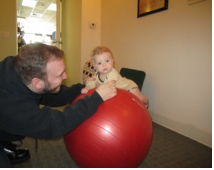 Did you know that Pediatricians and physical therapists are concerned that babies are spending too much time on their backs when they are awake? Parents are encouraged to get their babies to spend at least 30 minutes a day on their tummies while they are awake. We call this "Tummy Time". Parents sometimes forget how important it is to have their infants spend time on their tummies! However, it's often difficult to get babies to play in this position. Babies generally resist "Tummy Time" and may protest loudly when parents turn them over. Babies who have not been put on their tummies from the very beginning may experience this as an unfamiliar position and babies don't particularly like positions that are unfamiliar.
Did you know that Pediatricians and physical therapists are concerned that babies are spending too much time on their backs when they are awake? Parents are encouraged to get their babies to spend at least 30 minutes a day on their tummies while they are awake. We call this "Tummy Time". Parents sometimes forget how important it is to have their infants spend time on their tummies! However, it's often difficult to get babies to play in this position. Babies generally resist "Tummy Time" and may protest loudly when parents turn them over. Babies who have not been put on their tummies from the very beginning may experience this as an unfamiliar position and babies don't particularly like positions that are unfamiliar.The Top Ten Reasons for your Baby
to do "Tummy Time"
l. "Tummy Time" gets babies off of their backs and provides a break for the posterior occipital area (back of the head). This lessens the chance that your baby will develop positional plagiocephaly (a flat or asymmetrical head), which might require helmet therapy.
2. "Tummy Time" lessens the chance that your baby will develop acquired torticollis which involves neck muscle shortening when a baby's head maintains primarily one position. Sometimes babies may need some physical therapy for a while to correct this condition.
3. "Tummy Time" promotes the development of strong head and neck muscles by allowing your baby the chance to hold his head up against gravity. This paves the way for your baby to push up, roll over, sit up, and crawl later. "Tummy Time" is related to faster achievement of these developmental milestones.
4. "Tummy Time" is great for stretching and giving the abdominal organs a sort of "massage" which then stimulates normal bowel functioning and can help to eliminate baby gas.
5. "Tummy Time" enhances posture and coordination.
6. "Tummy Time" helps to develop your baby's visual system including tracking.
As your baby lifts his head while on his tummy he looks to both sides. This helps the coordination of 2 eyes together as he follows movement and looks for interesting toys positioned in front of him.
7. "Tummy Time" helps to develop your baby's throat and mouth area muscles as your baby looks up and moves his head. These are some of the muscles needed for speech and language development later.
8. "Tummy Time" reduces any tightness in the head and neck muscles. For your baby's brain and nervous system to function at their best the head and neck muscles need to be as free as possible from tightness.
9. "Tummy Time" helps babies to develop both near and far vision. We call this "visual organization" which begins while they are on their tummies. "Visual organization" is especially important later on when your baby grows and finally goes to school. He will need this organization as his eyes switch back and forth from blackboard to desk.
10. "Tummy Time" simply promotes good health and prevents problems related to motor development and learning later. Prevention of problems is always better and easier than trying to fix problems after they happen.
Learn how to get your baby to LOVE "Tummy Time". We will give you ideas and activities you can utilize at home, some of which we will actually practice during the workshop, to make sure your baby gets enough "Tummy Time" throughout the day. Our "Tummy Time" activities are enjoyable for both babies and parents. You and your baby will have fun! For more information about "Tummy Time” or to ask questions about the content in this blog, contact:
 Nathan attends Marilee’s “Mommy & Me” group at the Hollywood Pump Station. He has been practicing "Tummy Time" in the group since he was one month old and really enjoys it! So does his dad!! (picture used with permission)
Nathan attends Marilee’s “Mommy & Me” group at the Hollywood Pump Station. He has been practicing "Tummy Time" in the group since he was one month old and really enjoys it! So does his dad!! (picture used with permission)» See All Pump Station Locations
» See All Pump Station Classes



